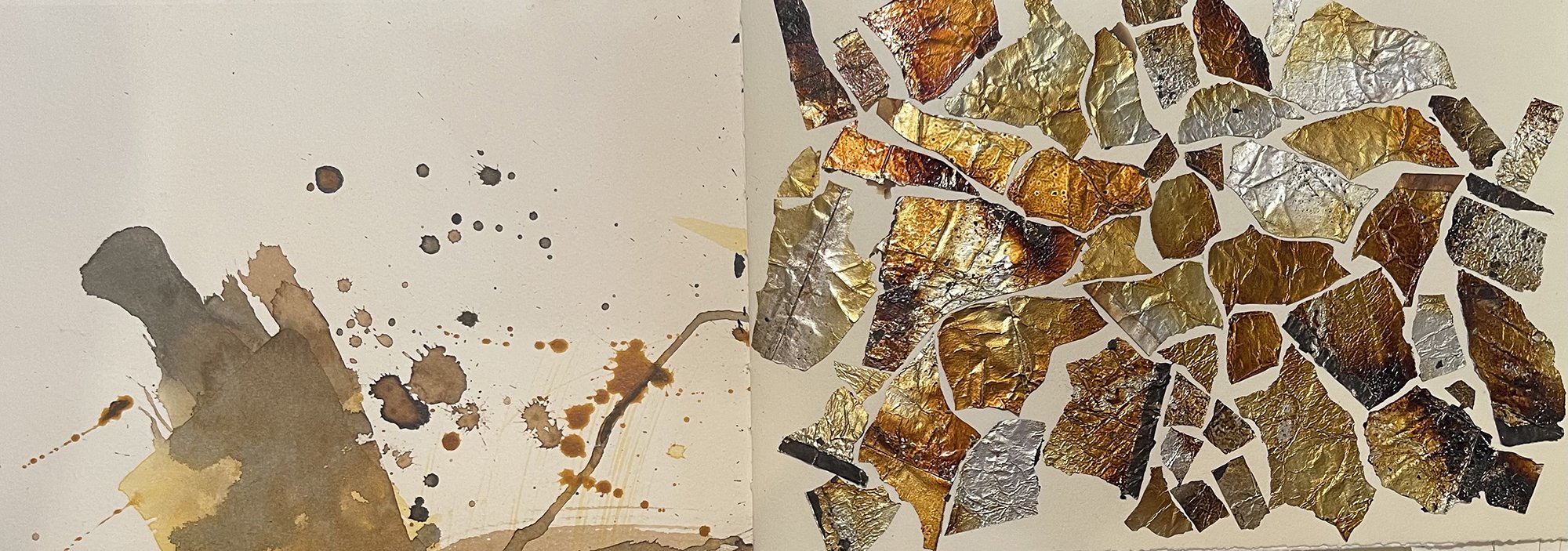Nulato: “The place we are tied together.” —Koyukon Indian
“Nulato: The place where we are tied together.” — Koyukon Indian
The spines of the books the students made in our class in Taos, New Mexico: Anita Barni, Romy Colonius, Louise Grunewald, Chris Kellogg, Ann Langston, Sydney McDonnell, Happy Price, Hollis Sutherland, Andie Thrams, Stacey Warther and Cathy Young.
Stitching the books always reminds me of the place we are tied together. Some part of each person is woven into each book, as a part of each of us was woven together. Being in a beautiful place for a week in a workspace without screens was compelling, it deepened the work, and what you see here is testimony to the budding ability and exuberance of this creative collaboration.
Our subject was Inscape and Landscape.
Book page by Louise Grunewald
The subject of inscape is inspired by Gerard Manley Hopkins’ idea of the need for contemplation in order to perceive the essence of a tree or a bird or the sea….or even perhaps to recognize our own purpose, as he declares in his poem As Kingfishers Catch Fire — “Crying Whát I dó is me: for that I came.”
The magnificent cottonwood tree outside our classroom.
Work by Andie Thrams
Everyone brought something into the classroom from the landscape. We did blind contour drawings that later became the structure for enlarged abstract paintings.
Abstract paintings (about 4” square) from gesture drawings and limited palette, as studies for larger paintings. — Anita Barni (left) and Cathy Young (right)
Blind contour drawings from the New Mexico landscape.
— Romy Colonius (left) Ann Langston (right)
Book page: Work by Andie Thrams
Book page: Work by Hollis Sutherland
Book page detail: Work by Andie Thrams
New Mexico is a place where landscape demands your attention; we saw snowflakes, sun, rain, hail, open desert and brilliant blue sky. On a clear night the open sky was studded with stars, and the crescent moon sat next to the Evening Star, Venus.
I introduced a new alphabet, designed to be accessible to calligraphers and non-calligraphers. The writing also became an abstract landscape:
Abstract landscape by Happy Price
Abstract landscape by Stacey Warther
Case for the book by Cathy Young
Absrtact study by Louise Grunewald
Abstract study by Andie Thrams
From abstract to representational with neutral watercolors. — Ann Langston
In the images below you can see traces of the alphabet I introduced to this class:
The sheet underneath her work made its own marks. Work by Anita Barni
“Blind contour writing” with our new alphabet. Work by Chris Kellogg
Book page by Andie Thrams
Book page by Sydney McDonnell
We explored all kinds of writing tools for students experienced and unexperienced with calligraphy.
We worked with mixing neutrals from a limited palette of one yellow, one red and one blue.
This is the limited palette I suggested. Book page by Louise Grunewald
Mixing neutrals from our three primary colors. Book pages by Happy Price (left) and Romy Colonius (right)
Do you have stories of collaboration, or co-creation with the natural world? I’d love to hear from you.





















